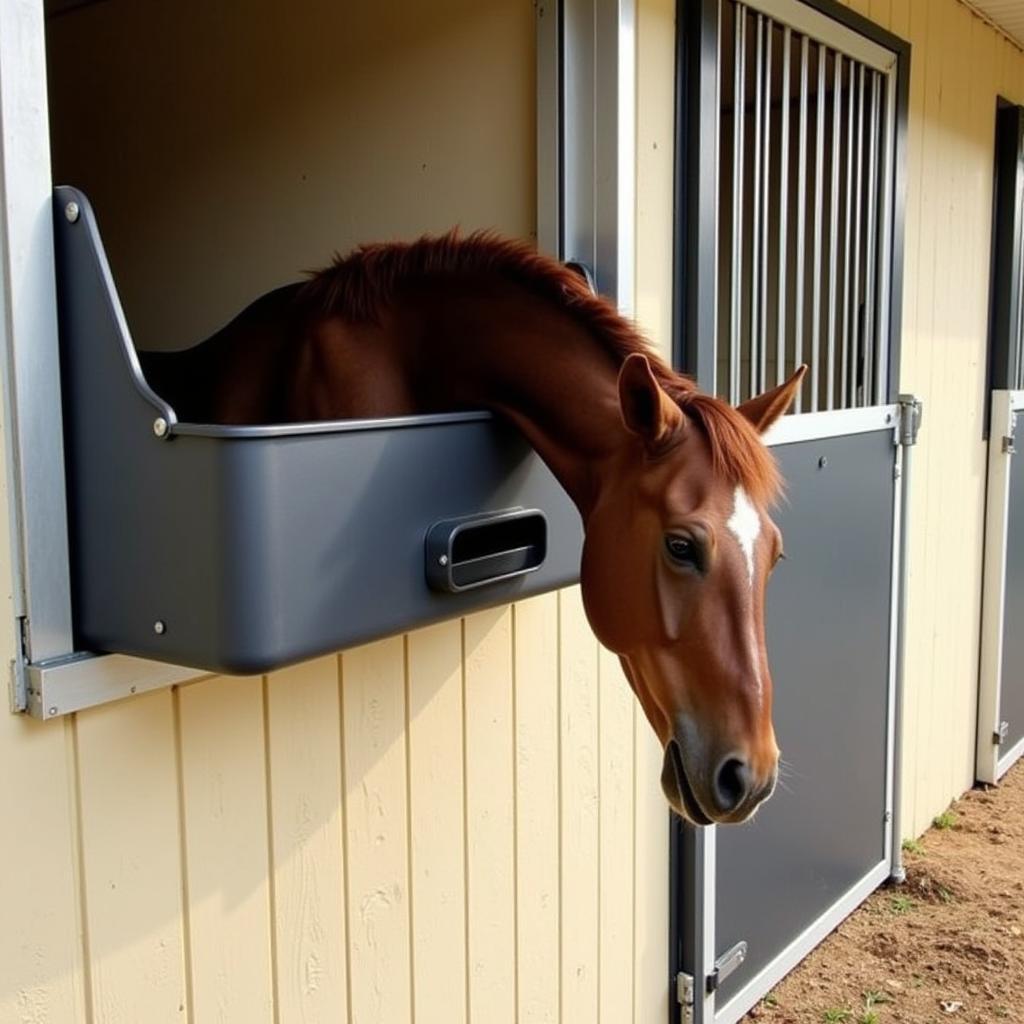A Horse Fence Feeder is a valuable addition to any pasture, providing a dedicated space for feeding hay and supplements. It not only helps with portion control and minimizing waste but also promotes natural grazing behaviors in horses. With various types of horse fence feeders available, it’s essential to choose one that best suits your horse’s needs and your pasture setup.
Understanding the Benefits of Horse Fence Feeders
Before delving into the different types, let’s explore why using a horse fence feeder is beneficial:
- Reduced Hay Waste: Fence feeders prevent hay from being trampled and soiled, saving you money and keeping your horse’s feeding area cleaner.
- Promotes Natural Grazing: By positioning the feeder at ground level, horses can mimic their natural grazing posture, which is better for their digestion and overall health.
- Portion Control: Fence feeders allow you to provide a specific amount of hay, which is especially helpful for horses that need to watch their weight.
- Minimizes Digestive Upset: Slow-feed hay nets, a type of fence feeder, help prevent horses from eating too quickly, reducing the risk of choke and other digestive issues.
Types of Horse Fence Feeders
There are several types of horse fence feeders, each with its pros and cons:
1. Hay Nets
Hay nets are a popular and affordable option. They come in various sizes and can be filled with hay or hay pellets. You can hang them from fence posts or rails at a suitable height for your horse.
Pros:
- Affordable
- Portable and easy to move
- Promotes slow feeding
Cons:
- Can be time-consuming to fill
- May not be suitable for all horses (some may chew on the net)
For more information on hay holders, check out our guide on horse feed holder.
2. Hay Racks
Hay racks are typically larger than hay nets and are designed to hold a more significant volume of hay. They come in various materials, such as metal or heavy-duty plastic.
Pros:
- Hold a large volume of hay
- Durable and long-lasting
Cons:
- Can be bulky and difficult to move
- Hay can still be wasted if not designed properly
If you’re interested in exploring other options for securing your horse’s feed, take a look at our selection of bucket holders for horses.
3. Wall-Mounted Feeders
 Wall-Mounted Horse Feeder
Wall-Mounted Horse Feeder
As the name suggests, these feeders are mounted directly onto a wall or fence post. They are a good option for horses in stalls or smaller paddocks.
Pros:
- Space-saving
- Reduces waste by keeping hay contained
Cons:
- Requires permanent installation
- May not be suitable for horses that tend to paw or push against feeders
Choosing the Right Feeder for Your Horse
Consider these factors when selecting a horse fence feeder:
- Your Horse’s Size and Eating Habits: Choose a feeder size that comfortably accommodates your horse. If your horse is a messy eater, opt for a feeder with a deep tray or consider using a hay net.
- Number of Horses: If you have multiple horses, you’ll need multiple feeders or a larger feeder to ensure everyone has access to food.
- Pasture Layout: Think about where the feeder will be most convenient to fill and access.
- Budget: Fence feeders range in price, so it’s important to choose one that fits your budget.
“When choosing a feeder, always prioritize your horse’s safety,” advises Dr. Emily Carter, a veterinarian specializing in equine care. “Ensure the materials are non-toxic and that there are no sharp edges that could pose a risk to your horse.”
Maintaining Your Horse Fence Feeder
Once you’ve chosen your feeder, proper maintenance is crucial:
- Regular Cleaning: Regularly remove any uneaten hay, debris, and manure from the feeder and the surrounding area.
- Check for Damage: Inspect the feeder regularly for any signs of damage, such as rust, cracks, or loose parts. Replace or repair as needed.
- Store Properly: If you’re not using the feeder during certain seasons, clean it thoroughly and store it in a dry place to prolong its lifespan.
Providing your horse with a dedicated feeding space is essential for their health and well-being. A horse fence feeder not only minimizes waste and promotes natural grazing habits but also makes it easier for you to manage your horse’s diet effectively.
FAQs About Horse Fence Feeders
1. Can I leave a hay net up all the time?
While hay nets are great for slow feeding, it’s not recommended to leave them up all the time. Constant access to a hay net can lead to overeating and potential weight gain.
2. How high should a horse fence feeder be?
The ideal height for a fence feeder is at or slightly below your horse’s chest level. This allows for a natural grazing posture.
3. Can I make my own horse fence feeder?
Yes, there are many DIY horse fence feeder plans available online. Just be sure to use safe and durable materials.
Need More Help?
Choosing the right horse fence feeder is an important decision. For personalized advice and assistance in selecting the perfect feeder for your horse, our team at Justus Horses USA is here to help. Contact us at 0772127271, email us at [email protected], or visit us at our location at QGM2+WX2, Vị Trung, Vị Thuỷ, Hậu Giang, Việt Nam. We’re available 24/7 to answer your questions and provide expert guidance.